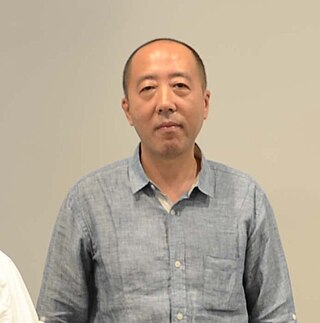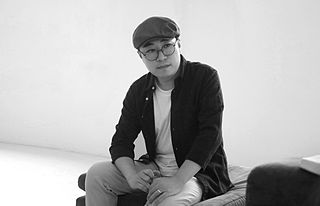Related Research Articles

Zhang Dali is an artist based in Beijing.
Sui Jianguo, professor and ex-chairman of the Department of Sculpture in Central Academy of Fine Arts in Beijing, is a contemporary Chinese artist.
Qiu Zhijie is a contemporary Chinese artist who works primarily in video and photography. Overall, Qiu's work suggests the struggle between the forces of destiny and self-assertion. Other common themes are social fragmentation and transience.

Zhang Xiaogang is a contemporary Chinese symbolist and surrealist painter. Paintings in his Bloodline series are predominantly monochromatic, stylized portraits of Chinese people, usually with large, dark-pupiled eyes, posed in a stiff manner deliberately reminiscent of family portraits from the 1950s and 1960s. Recently, he also created sculptures, translating for the first time into three dimensions many characters of the sort seen in his "Bloodlines—Big Family" portrait series. These sculptures have featured in many exhibits and continue his work as one of China's leading, and most highly sought-after, contemporary artists.

Shi Xinning is a painter based in Beijing.
Liu Wei is a Chinese artist based in Beijing. He works in varied media – video, installation, drawing, sculpture, and painting – with no uniting stylistic tendency, though the Saatchi Gallery finds a uniting theme of "a sentiment of excess, corruption, and aggression reflective of cultural anxiety". Conceptualism, satire, and humor are the hallmarks of his works.
Xia Xiaowan is a painter.
Li Qing is a Chinese artist based in Hangzhou, Zhejiang Province, China.
Shang Yang is a contemporary Chinese painter based in Beijing and is considered one of the most important painters of the life-stream movement. Known for his oriental humanist thought he believes landscapes are living things and puts their spirit into his brushwork. In 1965 he graduated from the Hubei Art Academy, where he then taught for several years. He received his masters from the Hubei Art Academy in 1981. Yang became the Associate President in 1989. Shang Yang became a Professor and the Officer-in-Charge of Fine Arts at the Research Institute of South China Normal University in 1993. Also in 1993, he became the Vice President of the Chinese Art painting Society. Shang Yang has exhibited extensively in China since the 1980s, including at Shanghai Biennale in 1996, and has shown internationally at galleries in London, Paris, Tokyo, St. Petersburg, and Helsinki. Shang Yang's work often appropriates images from traditional Chinese landscape painting, which are screened onto the canvas by a machine; he then distorts the image with graffiti or obtrusive geometrical designs. His works combine avant-garde exploration and solid artistic skill to create unique works of expressionism oil painting.
Wei Guangqing is a contemporary Chinese painter. He is known most of all for his Red Wall and Made in China Series. Wei Guangqing was one of the main members of the “85’s New Wave Art Movement”. In the 1990s he became one of the most well-known "political Pop artists". His work adopts a flat and symbolic composition, linking traditional ethics and modern culture. “Red Wall” is a symbolic work of pop art, using the traditional woodcarving-illustration prints and stories, through the process of Pop, to imply the various meanings of contemporary private and secular life. Wei Guangqing includes the contradictions of tradition and modernity by using a language related to cartoons and comic strips. His color palette consists of strong, often complementary colors. The artist creates a historical-ethical Pop with regional significance and uses the age-old tradition as a metaphor about today’s world.
Chambers Fine Art is an art gallery based in New York City and Beijing that specializes in Chinese contemporary art. Opened in New York in 2000 by Christophe Mao. Notable Chinese artists who had their first solo show in the United States at Chambers include: Lu Shengzhong, Shi Jinsong, Hong Hao, Qiu Zhijie, Hong Lei, and Chi Peng.
Liu Ye is a Beijing-based contemporary Chinese painter known for his bright-hued paintings of childlike female figures, his favorite cartoon character Miffy the bunny and works inspired by Piet Mondrian. Liu Ye is part of a generation of artists who grew up during the Cultural Revolution. However, unlike most acclaimed Chinese contemporary art, his works have little political implications. Instead, he prefers to use a universal language to depict his inner world. His work has been exhibited extensively in China, Europe and the United States.
Qiu Shihua is a Chinese landscape painter. He lives and works in Beijing and Shenzhen.
Wong Sau-ching (王守清)is a Hong Kong visual artist from the Art Of Nature International Company Limited.

Yang Yongliang is a Chinese contemporary artist.
Liu Chuang (刘窗)) is a Chinese artist who currently lives and works in Beijing. He was born in 1979 and graduated from Hubei Institute of Fine Arts in 2001. His work, "Buying Everything on You" was featured in The Generational: Younger Than Jesus exhibition that took place at the New Museum in 2009. The show was curated by Massimiliano Gioni. As part of an ongoing project, "Buying Everything on You" was also on view at Frieze New York 2013, and was presented by the Shanghai-based gallery Leo Xu Projects.
Chi Peng is a Chinese-born artist who lives and works in Beijing, China.

Nan Qi or Nan Xi is a Chinese artist based in Beijing. He is best known for his "halo dot" paintings which combine traditional Chinese ink painting methodology with modern technology, creating a "Ben-Day" dot effect.
Yu Xingze is a Chinese contemporary visual artist living between Bochum, Beijing and Shanghai.
References
- ↑ , Credit Suisse Today Art Award 2010
- ↑ Biography Archived 2007-09-27 at the Wayback Machine , Chambers Fine Art
- ↑ , designboom.com, Shi Jinsong
- ↑ , Saatchi Gallery, Shi Jinsong
- ↑ , Artcat, Shi Jinsong, Ne Zha – A Child’s Boutique
- ↑ Na Zha Baby Boutique Archived 2007-09-27 at the Wayback Machine , Chambers Fine Art catalogue
- ↑ "Jinsong Shi | Creonn". Archived from the original on 2009-12-24. Retrieved 2012-04-29., Barbara Pollack, Creonn, Jinsong Shi
- ↑ , Credit Suisse Today Art Award 2010
- ↑ , designboom.com, Shi Jinsong
- ↑ , Art for the world, Shi Jinsong: The Independent Foot of Crane
- ↑ , PENETRATE: Shi Jinsong Solo Exhibition
- ↑ "Jinsong Shi | Creonn". Archived from the original on 2009-12-24. Retrieved 2012-04-29., Barbara Pollack, Creonn, Jinsong Shi
- ↑ , Indepth Art News, ‘Shi Jinsong: Na Zha Baby Boutique
- ↑ , the cool list, Tree Motorcycles by Shi Jinsong
- ↑ "Shi Jinsong's Metallic Motorcycles | ArtZineChina.com | 中国艺志". Archived from the original on 2010-05-18. Retrieved 2012-04-29., Li Danni, Artzine, Shi Jinsong’s Metallic Motorcycles
- ↑ "Shi Jinsong's Metallic Motorcycles | ArtZineChina.com | 中国艺志". Archived from the original on 2010-05-18. Retrieved 2012-04-29., Li Danni, Artzine, Shi Jinsong’s Metallic Motorcycles
- ↑ , the cool list, Tree Motorcycles by Shi Jinsong
- ↑ "Shi Jinsong's Metallic Motorcycles | ArtZineChina.com | 中国艺志". Archived from the original on 2010-05-18. Retrieved 2012-04-29., Li Danni, Artzine, Shi Jinsong’s Metallic Motorcycles
- ↑ , Art for the world, Shi Jinsong: The Independent Foot of Crane